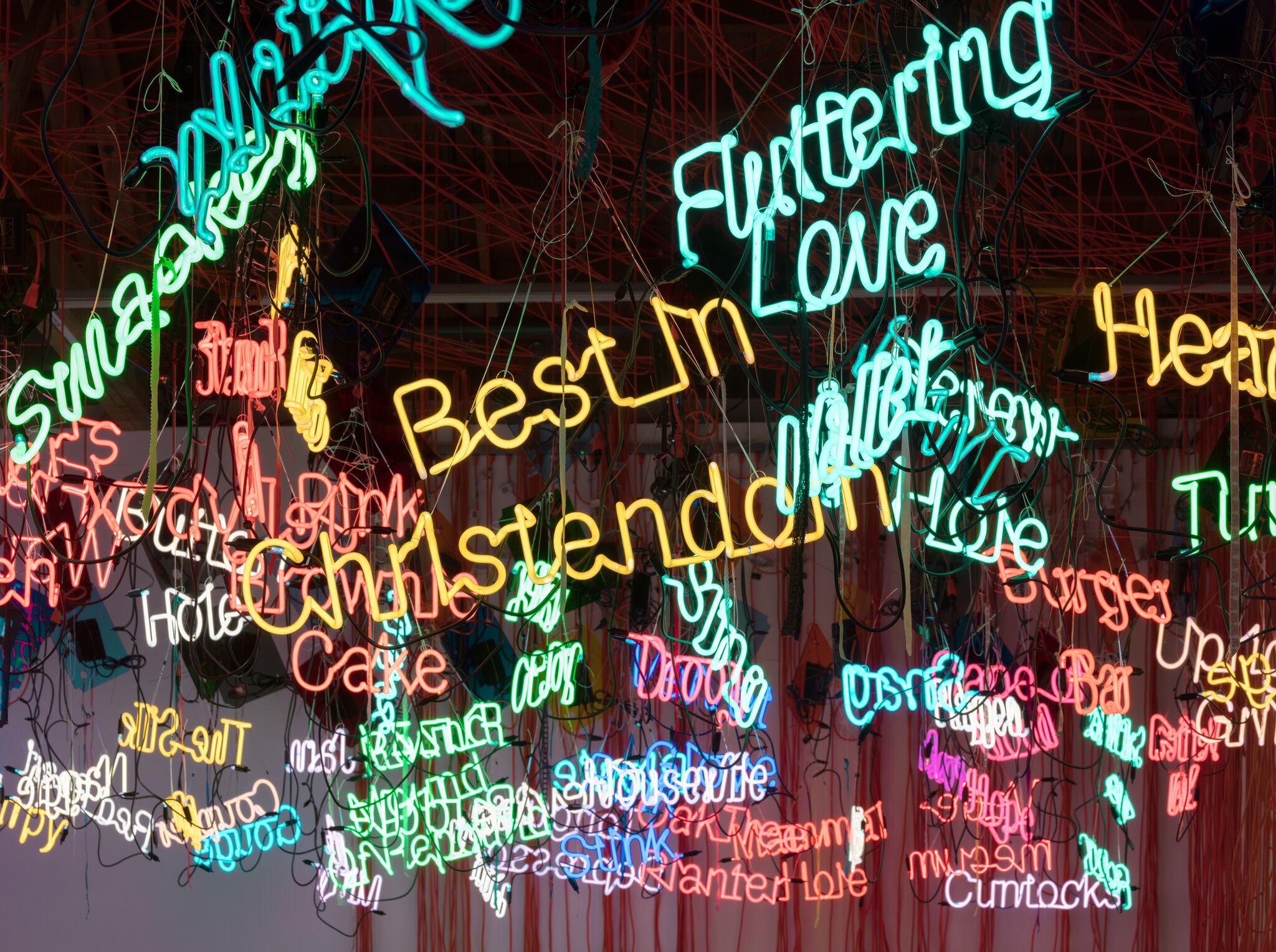Words by Marc Haefele, Senior Arts Writer, Bermudez Projects
Not to mention those several hundred glowing, multicolor neon signs dangling over several of the exhibits, each one showing a different synonym for “pussy.” A quest for synonyms of this word was Rhoades’ signature obsession – he claimed to have found 7,000 of them in many languages, including Ebonics and Hip Hop. They dangle, entice and loom here like so many exotic beer signs – Thatch Hatch; Love Socket; Love Muscle, on and on. You imagine that the mere cost of the electric current this exhibit demands has to be exorbitant.
And yet there is infinitely more to see in the six different installations here. Saying they work on many levels is not merely a figure of speech. The installations deploy above you, below you, in front and around you. There’s an ancient Japanese shrine known as the All-Day-Long-Seeing Temple. You could spend all week, or maybe all months, involving yourself in the contemplation of any of these installations, with their vulgar neon clouds, polished rocks, strewn rugs, bundles of firewood wrapped in porn photos, Indian dream catchers, cowboy hats, porcelain burros and mules; junked but functioning auto electronics, blatting out top-40 radio, and hundreds of categories of other things. Each object to its own prescribed, preordained place in the artist’s schema.
I overheard a gallery technician describing the process of assembling and disassembling Rhoades’ works: “Each time we do it we learn something new.”
Rhoades himself continuously changed much of his work – or maybe his installations were always works in progress. He once said, “I am uncomfortable with actually finishing something.” The works here have evolved in stages: Black Pussy was once Black Pussy Soiree Matinee, a de facto private-party venue that included several cabaret shows.
It also includes embodiments, in the form of modern consumer goods, of the legendary 360 Arab pagan gods that Mohammad anciently banished from the holy precincts of Mecca’s Ka’abah. Hence, the Pagan Idols.
Rhoades said in an interview that Black’s concepts mutated toward the Tijuanatangierchandelier installation, which was his last work.
It is a realization and to the extent that anything that dangles glowing renditions of 176 different words for woman’s pudenda can be said to be so, an amelioration of the preceding five works. Here, more than previously, Rhoades can be said to have attained a certain focus – on the similarities of two separate mass-market tourist exoticisms: fake maracas, sombreros; bogus designer handbags; Moroccan hanging lights and so on. The gimcrackery here was assembled by the artist in acquisitive forays to these two “exotic” Mexican and North African border-town locations, 6,000 miles apart; the purchases showing in the great similarities of their modest commercial intentions a world in which cultural differences blend into a tacky intercontinental conformity of sundered perceptions.
It is a singular, powerful and coherent statement, and you cannot but sadly wonder where he would have gone from this point, attained shortly before his death in 2006.
I found the four earlier assemblages inspired and sometimes extremely entertaining, even as they lacked the sense of consummation of Tijuanatangierchandelier.
The first, the 1994 Swedish Erotica and Fiero Parts is a random symphony of yellow objects (dishes, legal pads) and random scraps of paper, wood, cardboard, plastic foam. Originally there was yellow Fiero coupe parked outside. I didn’t see it this time. The 1995 My Brother/Brancuzi creates a tribute to Rhoades’ sibling and one of his favorite artistic influences, slamming the one’s bedroom into the other’s studio. The third, The Creation Myth, is the most involved of all the works on show, and in some ways the most entertaining. There is a great deal of programmatic material here, with a subtitle of The Mind, the Body and the Spirit, the Shit, Prick and the Rebellious Part. Screens flash, smoke puffs, there is a form of sketchy corpus stretching over the whole, and, my favorite part, an “O” gauge model Jersey Central steam locomotive with a fake snake head that circles a track through the entire thing. With its incorporation of discarded consumer electronics and its multiple narratives, Myth recalls some of the larger works of the astounding Native-American artist Jimmy Durham, now showing at the Hammer.
In 2004’s My Madinah, in pursuit of my ermitage, Rhoades seems to take a deep breath, and step back from the mad, compulsive inclusiveness of “Myth.” Despite the dangling tangle of freshly-harvested vulva words, there is a certain languor to the piece/place, an openness, and spectators are urged to take of their shoes and roam peacefully among the dozens of throw rugs cast on the “madinah’s” floor.
The elicitation is one of sanctuary. A peace that Rhoades’ work would never evoke again.
Jason Rhoades
The Creation Myth
1998
Mixed media
Dimensions variable
Installation view,
Jason Rhoades. Installations, 1994 – 2006
Hauser Wirth & Schimmel, 2017
© The Estate of Jason Rhoades
Courtesy Friedrich Christian Flick Collection im Hamburger Bahnhof, Berlin
Photo: Fredrik Nilsen
Jason Rhoades
Tijuanatanjierchandelier
2006
Mixed media
Dimensions variable
Installation view,
Jason Rhoades. Installations, 1994 – 2006
Hauser Wirth & Schimmel, 2017
© The Estate of Jason Rhoades
Courtesy the estate, Hauser & Wirth, David Zwirner and lender
Photo: Fredrik Nilsen
Jason Rhoades
My Madinah. In pursuit of my ermitage…
2004
Mixed media
Dimensions variable
Installation view,
Jason Rhoades. Installations, 1994 – 2006
Hauser Wirth & Schimmel, 2017
© The Estate of Jason Rhoades
Courtesy the estate, Hauser & Wirth and David Zwirner
Photo: Fredrik Nilsen





